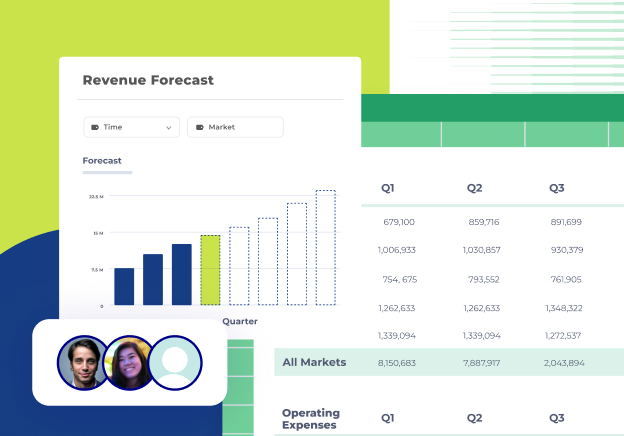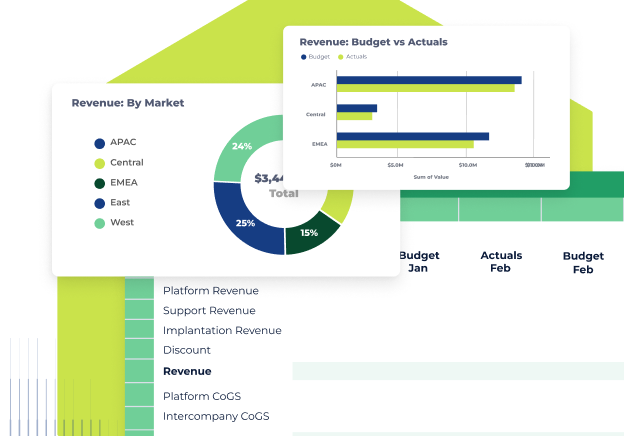What is strategic planning?
The strategic planning process is how a business determines how to achieve its short-and-long-term financial objectives. The goal of strategic management is to ensure a great ROI (return on investment) for the business and its stakeholders in the future.
The outcome is the strategic plan and the strategy implementation process.
It uses data analysis, creative strategies, and team management to promote profitability, growth, and the long-term success of a business.
Strategic vs tactical financial management
Strategic financial management focuses on long-term wins while tactical financial management is about the short-term.
Business owners use tactical financial planning to see more immediate success. While it’s helpful for day-to-day survival, making decisions without looking at the entire picture is risky.
Using strategic financial management, leaders take actions that support a company’s long-term goals. They might take a loss this year in order to see success two, five, or even ten years down the road.
Both tactical and strategic decisions have their place in a profitable business.
Strategic planning vs. financial planning
Strategic planning is the process of creating and implementing business strategies designed to promote the long-term health of an organization.
It’s a disciplined effort that produces fundamental decisions and actions that shape and guide what an organization is, who it serves, what it does, and why it does it. Effective strategic planning allows an organization to see where it’s going, the actions needed to get there, and how to determine success.
Financial planning is the task of determining how a business will afford to achieve its strategic goals and objectives. It provides a top-down operational framework to explore various scenarios.
Usually, a company creates a financial plan immediately after determining its vision and objectives. Leaders ask themselves how the business will stack up in the next one, five, or even 10 years—and where they want it to be.
Financial planning teams outline how the company will meet those goals with current and projected resources. Executives then build out infrastructure and make decisions based on this information.
While it’s important to create both strategic and financial plans, a business needs both. The financial data provides benchmarks for management to track, and strategy prioritizes long-term success over short-term rewards.

How to create a strategic financial management and planning process
Financial planning & analysis teams (FP&A) often lead strategic planning initiatives. FP&A enhances the finance department's ability to manage performance by integrating corporate strategy and decision-making.
From routine activities—like financial close and consolidation, cash flow analysis, and financial reporting—to strategic initiatives—including financial insights on planning, budgeting, financial forecasting, and financial modeling—FP&A covers a lot of ground.
Let’s see how they approach developing a strategic plan.
1. Define objectives and goals
Make financial objectives that are specific, measurable, and have a timeframe. Include goals for both the company and its shareholders.
A company's vision statement or mission statement are good places to begin your strategy formulation. What values comprise the company culture? Leadership should be clear on this before moving forward.
Next, you want to set specific goals and specific time blocks to achieve them. Your financial modeling software can help here.
2. Gather data
Next, you need to gather your company's finances from each internal department and every external source.
You’ll want all the data, including:
- Cash flow
- Accounts receivable and payable
- Expenditures
- Revenue
- Earnings
- Resources
- Cash conversion cycle
Now's a good time to involve your financial analysts or financial consultants. If your finances are decentralized, that data might live in unsuspecting places, like human resources. This is an opportunity to look at your Accounting process, too.
3. Analyze company data
Are your goals aligned with your current performance? What adjustments have to be made?
FP&A analysts use predictive planning, driver-based planning, and multi-scenario planning to determine the company’s current standing and potential future. Regardless of the technique, analysts must collaborate with every department when planning—silos are not helpful here.
Luckily, today's financial planning software makes a collaborative analysis process much easier.
4. Develop and share the plan
Armed with your analysis, it’s time to determine how you’ll meet your financial targets. This will often involve:
-
Budgeting: The budget’s primary goal is to determine which financial resources to allocate to each part of the company, from salaries to office supplies. The focus of a budget revolves around cash position, including expected revenues and expenses, to create specific financial goals for the foreseeable future.
-
Forecasting: A forecast’s undefined nature allows it to be used for both short- and long-term projections and adapt to recent performance data. Executives can make changes in real time to meet the necessary goals, adjusting their operations, such as production, marketing approach, and staffing.
-
Scenario analysis: Scenario planning runs various outcomes in a single budget or plan. A common example is drawing various outcomes from an annual operating budget to improve business decisions around resource allocation and adjustment. While this is an analysis, it can be used in the planning stage.
As you identify areas and business units to allocate additional resources to, check in with your mission statement again.
Once a plan is determined, you’ll need to share it with all team leaders so they can build out and manage their team members based on these goals.
5. Implement & Manage
You now have a clear, data-backed plan to follow. But team leaders must implement the plan and set up financial controls so the company stays on track.
This stage requires consistent financial decisions, identifying issues, and taking corrective actions when needed.
Without this step, your plan is just a plan—not a way for your company to see success.
6. Tracking Success
Managing the strategic plan also requires continuously reviewing, planning, and adjusting actions to support long-term objectives.
Financial teams should evaluate specific metrics—like important financial ratios—to see if the plan is being followed, if it’s working, and what might need to change.
What metrics? Let’s take a look.

Metrics to know for strategic financial planning and management
Both metrics and KPIs (key performance indicators) help leadership get a pulse on company performance. KPIs specifically track a company’s progress toward achieving strategic initiatives.
KPIs are metrics that clearly show which goals the business needs to meet in order to keep progressing towards long-term success. The following KPIs will guide your strategic planning and management.
SaaS magic number
The SaaS magic number is a metric that quantifies a company’s sales efficiency. It measures the output of a year’s worth of revenue growth for every dollar spent on sales and marketing.
To calculate the magic number for your SaaS business, you subtract the prior quarter's annual recurring revenue (ARR) from the current quarter's ARR. You then divide it by your total customer acquisition cost (CAC) or the total sales and marketing spend from the previous quarter.
The SaaS magic number helps leaders make decisions on:
-
Market calibration: Markets change, so marketing will always require adjustments. Knowing your SaaS magic number (and seeing its trend) signals when it's time to recalibrate your marketing.
-
Sales adjustments: Trends in your magic number can signal that it's time to adjust your sales methods and messaging. You can then focus on and refine those areas.
-
Cost reduction: A higher SaaS magic number can signal that it's time to shift focus to optimizing your business's finances so that you see more of that revenue as profits.
Net dollar retention
Net dollar retention (NDR) is a SaaS metric that measures how much your monthly or annual recurring revenue is fluctuating. NDR, which can also be referred to as net revenue retention (NRR), looks at expansions, downgrades, and churn rates to indicate business growth.
-
Expansions are increases in monthly spending from a customer. For instance, customers may upgrade to a more expensive plan, incur more usage charges, or increase their product portfolio through cross-selling.
-
Downgrades are reductions in monthly spending. This occurs when a customer moves to a lower tier plan or reduces their usage.
-
Churn occurs when a customer cancels their subscription or stops using the service entirely.
NDR offers the most transparent view of growth within your existing base. It can help head off retention issues that can take a long-term toll on revenue.
Cash runway
Simply put, your cash runway is the amount of time you can operate at a loss before running out of money. How long will your current funds last without new investments coming in?
In other words: it's a measurement of your cash flows.
In order to calculate a cash runway, you divide how much money you have by your burn rate. Burn rate is usually measured by the amount of money spent each month, though it can be calculated for different time periods.
Cash runway shows how profitable your company is—or if it’s overspending. If your cash runway is continuously high, your strategic financial plan may be off track.
Churn rates
Churn happens whenever a customer stops doing business when a company. Churn rates measure both revenue churn and customer churn.
Revenue churn is the percentage of revenue lost to cancellations and downgrades and customers. Customer churn is the number of customers lost.
Customer churn answers the question: What percentage of customers did we lose in the past month?
Revenue churn answers the question: What percentage of revenue did we lose in the last month?
The opposite of the churn rate is the growth rate. The growth rate is the rate at which a company gains new subscribers or new employees. In order for a company to grow, the churn rate of subscribers cannot exceed the growth rate.
Debt-to-Equity ratio
The Debt-to-Equity ratio compares the total liabilities of a company to its shareholder equity, offering insights into how much of the company's operations are financed through debt versus equity.
This is calculated using two key components: Total Liabilities, which include all debts and financial obligations and Shareholder Equity, representing the company's net value (total assets minus liabilities).
A higher Debt-to-Equity Ratio suggests that a company is more heavily financed through debt, which may indicate higher financial risk but also potential for higher returns.
LTV/CAC ratio
LTV is the lifetime value of a customer and CAC stands for customer acquisition cost. The LTV/CAC ratio compares the value of a new customer over her lifetime relative to the cost of acquiring that customer.
If you spent $10 to acquire a customer and the LTV is $100, then you have a good LTV/CAC ratio. If you spent $1,000 to acquire a customer and the LTV is still $100, then you need to adjust the ROI of your sales and marketing spend.
The ideal LTV/CAC Ratio for early-stage (high growth) companies is 3:1.
If your LTV/CAC Ratio is above 3:1 (like 6:1), then you're probably missing out on business. You have the funds to expand your sales and marketing team and go after tougher-to-acquire customers.
If your LTV/CAC ratio is below 3:1 (say, it's 2:1 or 1:1), then you're spending too much on sales and marketing. Or, you need to increase the LTV of your existing customers.
Rule of 40
The rule of 40 is a principle that the growth rate and profit margin of a company should be greater than 40%. Usually, the Rule of 40 will result in an interchange between growth and profit, since it’s rare to have both be equal or high at the same time.
When balancing out the equation, it’s more common with high growth revenue to have lower profit margins, or with low growth to have higher profit margins.
This rule of 40 was developed by venture capitalists to quickly assess the performance of small fast-growing companies. As companies mature, they shift from a focus on growth towards a focus on profit—hopefully keeping steady at the rule of 40.
Aligning strategic financial planning with organizational goals
Strategic financial planning ensures that financial targets and activities are not just numbers on a spreadsheet, but tools that work in tandem with the organization’s broader objectives. Here's how strategic financial planning aligns with organizational goals:
Understanding Organizational Vision and Goals: The first step in alignment is thoroughly understanding the organization's long-term vision and immediate goals.
Setting Realistic Financial Targets: Strategic financial planning involves setting realistic and achievable financial targets. These targets should be challenging yet attainable and should directly contribute to achieving the broader organizational goals.
Resource Allocation Aligned with Priorities: Allocate financial resources in a way that prioritizes projects and initiatives critical to the organization's success. This ensures that funds are used effectively to support key strategic areas.
Performance Monitoring and Adjustment: Regular monitoring of financial performance against the set goals is essential. This involves adjusting strategies in response to changes in organizational direction or external factors affecting the business.
Communicating Financial Strategies Across the Organization: Transparency and communication are key. Making certain that all stakeholders understand how the financial strategy aligns with the organizational goals fosters a cohesive and focused effort towards achieving these goals.
Integrating ESG criteria into strategic planning
In today's business landscape, the integration of Environmental, Social, and Governance (ESG) criteria into strategic planning is not just a trend but a vital component of sustainable business practices.
ESG factors have become increasingly important in strategic financial planning, as they significantly influence investor decisions, brand reputation, and long-term profitability.
Environmental Considerations: Companies are focusing on reducing their carbon footprint, implementing sustainable resource usage, and adopting eco-friendly practices. This shift not only addresses environmental concerns but also caters to the growing market demand for green products and services.
Social Responsibility: Social criteria involve the company's stance and actions on social issues like labor standards, community engagement, and diversity and inclusion. By prioritizing these aspects, businesses can foster a positive workplace culture and enhance their social license to operate.
Governance Practices: Good governance practices encompass ethical conduct, transparency, and accountability in business operations. Adopting strong governance practices reduces risk and builds trust with stakeholders, including investors, customers, and employees.
Incorporating ESG criteria into strategic planning helps companies align with global sustainability goals and meet the evolving expectations of consumers, investors, and regulatory bodies.
Conclusion: the best way to manage your financial planning process
Strategic management is a perpetual process. FP&As must have a solid grasp of a company's short- and long-term financial needs so they can plan, budget, and forecast to support the strategic plan.
The tools they’re using for these tasks must improve as the business grows and as organizational complexity increases.
Cube is the first spreadsheet-native FP&A platform that functions as a single source of truth for your source systems and lets you quickly push and pull data into Excel or Google Sheets. Instead of replacing Excel—which was already working in every other respect—it adds a database. Cube’s database:
- Read ins and unites data from your source systems
- Organizes, consolidates, and cleans your data
- Bidirectionally interface with the spreadsheet through a native integration
In other words, Cube automates all the manual, error-prone work on Excel or Sheets so that you can focus on the analysis and forecasting that bring tangible results to your company.
Ready to see how Cube can accelerate your strategic financial planning and management? Book a demo today.
Sources cited:



.png)









.png)

.png)

